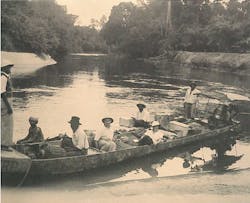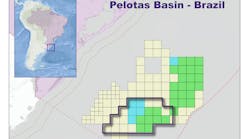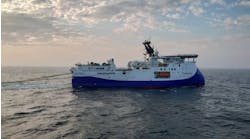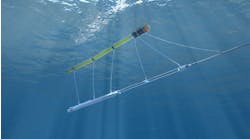Integrated geoscience packages help reduce exploration risk
Jo Firth,CGG
CGG hasworked in Africa for more than 85 years. From the first surveys in Gabon and Tunisia in the early 1930s, to today’s massive offshore 3D multi-client surveys, the company has consistently employed the latest technology to support the search for oil and gas in Africa.
In today’s economic climate, large multi-client surveys are becoming increasingly popular for both exploration and development teams. Since costs can be shared and larger surveys acquired for a better overall view of the prospect, they provide a cost-effective means of acquiring high-quality data. Even in relatively mature basins, where acreage is shared by many operators, multi-client surveys can be an efficient tool for use as an aid to development and near-field exploration. Access to large surveys in both mature and frontier areas allows oil companies to gain a better regional overview to reduce exploration risk at an early stage and helps to reduce the time required from license award to well drilling in new areas. Small proprietary surveys often leave holes in the data coverage, and usually have different acquisition parameters and azimuths, making regional exploration more challenging. Large continuous and consistent surveys help to reduce total exploration spending by drilling wells earlier and better de-risking. Having consistent high-quality coverage over complete blocks also makes definition of areas for relinquishment easier to determine.
CGG survey crew in a shallow boat on a stretch of river in Gabon in 1932.(Image courtesy CGG)
The company’s multi-client surveys are always processed using state-of-the-art sequences to provide the best possible images in an area and to deliver a regional study without compromising local detail. Today, almost all surveys are processed directly to depth (pre-stack depth migration), using advanced velocity model building workflows, which blend together technologies such as full-waveform inversion (FWI) and multi-layer tomography, and are overseen by expert practitioners with regional knowledge. These are increasingly driven by wells and include inversion for anisotropic parameters and incorporation of visco-elastic (Q) effects, where appropriate. Ghost wavefield elimination (GWE) delivers broadband wavelets for improved resolution, as well as deeper penetration beneath complex overburdens. The improved low-frequency content, combined with quality control throughout the processing sequence focusing on amplitude fidelity, amplitude versus offset (AVO) effects and comparison to wells (where available), provides data that is delivered ready for reservoir characterization.
Integrated geoscience packages
In addition to high-quality seismic data volumes, recent programs, such as CGG’s completed Gabon and current Mozambique surveys, also deliver JumpStart integrated geoscience packages. The major constituents of these packages are advanced multi-client geophysical and geological data, such as gravity, magnetics, satellite imagery, an upgraded and ready-to-use well data set, and a coherent interpretation and evaluation framework for the basin, which complement the seismic data. These value-added products can help jumpstart exploration in an area and accelerate development by providing the high-quality data needed to identify drill targets for appraisal and production wells further along the workflow. Provision of all these products from a single source can shorten decision times, and the integration of each into the broader workflow ensures better-quality data. The goal is to reduce the time spent by clients on conditioning and integrating the data and allow more time to be spent on the generation of new play models and identification of new prospects, or on the improvement of production from existing reservoirs.
These large multi-client surveys are frequently provided in collaboration with the local regulatory authority as part of a wider program of promotion of an area to attract investors ahead of a licensing round. By working in partnership with an internationally respected geoscience company, governments can attract international investment by offering opportunities with the backing of credible geoscience data and interpretation, and benefit from their experience in marketing and successful licensing round promotion. This enables governments to create an environment which nurtures the local oil and gas industry and the development of their natural resources. These programs usually also include development programs for the local regulators and national oil companies through knowledge-sharing and a comprehensive range of geoscience training courses that can be tailored to the local needs. This helps develop domestic resources and supports local technology and skills development.
A modern seismic vessel towing 14 streamers.(Image courtesy CGG)
Gabon
The Gabon South Basin survey is a prime example of a modern integrated multi-client geoscience package. The program was designed in collaboration with the Direction Generale des Hydrocarbures to cover all the blocks on offer for the 11th Licensing Round, as well as some held blocks, in order to provide a regional view of the basin. Ahead of the acquisition phase, existing legacy data and wave equation modeling were used to determine the optimal offsets, record length, fold and azimuth required as well as other acquisition parameters. The survey was acquired and processed using variable-depth-streamer technology to maximize the bandwidth. Although the survey covered 25,000 sq km (9,653 sq mi), acquisition was completed in nine months by using two vessels working in tandem. An advanced onboard processing system on one of the acquisition vessels enabled a fasttrack pre-stack time migration (PreSTM) data set for the 12,000 sq km (4,633 sq mi) acquired by this vessel (half of the total survey area) to be delivered just three weeks after the last shot. Both the full fasttrack PreSTM and a sample area of pre-stack depth migration (PreSDM), showing the potential of the data, were delivered four months after acquisition, in time for evaluation ahead of the licensing round closure. This feat shows that large surveys can be processed in a timely manner and need not cause delays. As part of the multi-client agreement, the licensing round was promoted at conferences, roadshows, online, and in print. Virtual data rooms were also made available via video conference link for potential bidders to view the data.
The subsurface imaging for this survey used the latest velocity model-building technology and was one of the first applications of full-waveform inversion (FWI) to a data volume of this size, and the first of its size in Africa. FWI was applied over the entire 25,000-sq km area down to the maximum depth reached by diving-wave penetration, which for this data set, acquired with 10-km (6.2-mi) long streamers, effectively coincided with the top salt boundary. Below this level, advanced tomography was used.
Depth slice over part of the Gabon South Basin 3D survey showing fine detail and clearly identifying turbidite channels.
The image demonstrates some of the details captured in the FWI velocity model. As well as the obvious turbidite channels, there is evidence of low-velocity anomalies possibly due to hydrocarbons and typically located directly above the salt diapirs. Incorporating these anomalies into the velocity model not only improves the image in both shallow and deep sections, but also yields additional useful information about the near-surface, its exploration potential, and possible geohazards.
Potential field data was acquired alongside the seismic data to model crustal types and thicknesses for input to basin modeling. The dense coverage of gravity and magnetic data acquired with the 3D seismic enabled production of a unique set of high-resolution anomaly maps for use as an aid to the velocity modeling for the seismic imaging. The available wells in the area were also re-interpreted and included in the velocity modeling but, since this is a frontier area, few wells were available in the survey area and none that penetrated the salt.
Since delivery of the final seismic data volume, two wells have been drilled in the survey area, namely Boudji-1 and Ivela-1, both of which found oil and were reported to tie well with the seismic. The Boudji-1 well discovered a 90-m (295-ft) column of good-quality oil-bearing sands and the Ivela-1 well found a 78-m (256-ft) gross oil column.
The full JumpStart integrated geoscience package for the Gabon South Basin is now complete. The study provides a new regional stratigraphic interpretation as well as source, reservoir and trap risk, and an additional detailed well-tied seismic interpretation with attributes based on the new 25,000-sq km BroadSeis data set. This integrated study is the definitive exploration resource for the deepwater Gabon margin.
A new deepwater 2D survey, outboard of the area covered by the 3D survey, is now planned to complement this study and help define the full extent of existing and new plays in the area. It will also aid understanding of the thickness variations in the sediment overburden for source rock maturity analysis. The broadband data will enable improved characterization of the turbidite systems and provide deep penetration with low frequencies to help describe the nature of the deep crust.
Fasttrack image from the new Mozambique 3D survey showing high-resolution shallow data and clearly defining structure in the basement.(Image courtesy CGG Multi-Client & New Ventures)
Mozambique
The new Mozambique survey, recently acquired over the Beira High region in the Zambezi Delta, will be another integrated geoscience JumpStart package to support a licensing round. This 15,400-sq km (5,946-sq mi) 3D survey is the first of the surveys agreed with INP in 2017, designed to accelerate understanding of the petroleum systems in the area. CGG plans to acquire more data in the area including the acquisition of 2D data in the Rovuma basin, which will link in with other planned 2D surveys in the region.
A fasttrack PreSTM data volume for the Zambezi basin survey is available to license now, ahead of the recently announced 2019 Licensing Round. This data set delivers high-resolution images of the Outer Zambezi Delta turbidite fans and channels as well as exciting detail of faulting and layering in the basement core of the Beira High that has not been seen before. It reveals key details of the prospective outer Zambezi Delta Complex and its interaction with the nearby Beira High. Subsurface imaging technology is being applied to deliver high-resolution shallow data at the same time as clear penetration and imaging of the deep data. The final PreSDM data set will be available in 4Q 2019.
Regeneration of older data sets
The major advances in subsurface imaging and velocity modeling techniques over the past few years mean that reprocessing even relatively recent data sets can deliver significantly improved images. In addition, the bandwidth of conventionally acquired data can be significantly extended using GWE so that it approaches that of modern broadband data.
Example section from the recently reprocessed Angola-00 survey in block 33.(Image courtesy CGG Multi-Client & New Ventures)
An example of this is the reprocessed Angola block 33 3D survey, which is now available. This survey was reprocessed using a broadband PreSDM imaging sequence, taking advantage of recent advances in bandwidth extension. The survey covers the Calulu discovery and lies approximately 10 km southwest of the giant Dalia field. Block 33 is largely underexplored, with significant potential, especially in the presalt section. As the known fields in this basin lie within Tertiary turbidites, the reprocessing has been especially designed to extend the bandwidth to improve the resolution of this unit, while also providing clearer imaging through the complex salt structures in the area owing to the deep penetration of the low frequencies.
Getting maximum value from legacy data
In addition to offering high-quality modern seismic data sets, the company also offers enhanced and revitalized legacy data from GeoSpec, who specializes in regenerating and digitally transforming legacy data. They provide workstation-ready, integrated data sets to expedite rapid evaluation of exploration opportunities. Depending on the type of data available, this may include scanning paper sections with reconstruction and migration of the data, reprocessing from field tapes, or migration of stacked data. The data is enhanced by time, phase, and amplitude matching to create consistent, zero-phased seismic, where possible tied to well data, and with navigation data quality controlled, updated, and converted to a consistent projection.
This type of enhanced legacy data is a useful starting point for promoting and evaluating assets. Pre- and post-stack legacy seismic data sets, well data, and any other information available, can be transformed, interpreted, and integrated to generate value-added products in consistent, workstation-ready formats. Consistent stratigraphic tops, tied to the seismic and well data, are used to generate a series of regional surfaces, well and seismic montages, dry well analyses, velocity models, stratal slices and other attribute volumes and interpretation products. These provide cost-effective basin-wide reconnaissance products based on consistent methods that can be used in data packages for licensing rounds to attract investor interest in frontier areas.
Frequency decomposition on a stratal slice of Cretaceous channel and fan taken from a GeoSpec TerraCubeREGRID volume offshore Cameroon.
In stratal slicing, the seismic volume is flattened in the geological time domain along an interpreted 3D horizon, to enable the mapping of lateral seismic facies variations along a constant depositional time slice. Changes in rock facies induce subtle changes in the seismic wavelet which are highlighted through spectral decomposition around three dominant frequencies. This provides a clear picture of lateral seismic facies and enables rapid evaluation of potential leads and prospects. The following image shows the frequency decomposition of a stratal slice from one of the Cameroon data packages. The Cretaceous channel and fan (from top left to bottom right) are clearly delineated.
Cameroon
The recent licensing round in Cameroon is an example of this use of legacy data. Data packages of enhanced legacy data were created for the Rio Del Rey and Douala/Kribi-Campo basins, the two areas with blocks available to license. These enhanced TerraCube data packages, consisting of workstation-ready, time- and phase-matched, contiguous regional regridded 3D seismic data sets, 2D seismic, and integrated well and seismic montages, combined with supplemental prospectivity reports, stratigraphic studies and databases, detailed the opportunities available for both basins ahead of the licensing round.
Cameroon is a proven hydrocarbon province with production from both these basins. Significant further opportunities exist for commercial hydrocarbon accumulations in both, with large tracts of open acreage available in the recent licensing round. The results of this have not yet been announced.
Conclusion
The company believes that integration of a range of geoscience data with the highest-quality seismic will become the gold standard for basin-scale multi-client studies. Incorporating insight gained from legacy data and knowledge of the geology into the survey design means that optimum data can be acquired, with the ideal offsets and azimuths to image the target. The JumpStart combination of the best seismic images with reservoir-quality data and value-added geoscience products can be used directly for exploration, play evaluation, well location optimization, geohazard identification and reservoir delineation, characterization and modeling. These integrated data packages are designed to provide a fuller understanding of the petroleum system and deliver insight which will reduce the time, risks, and challenges associated with exploration. This should mean that more successful wells can be drilled, and oil company experts can focus on finding new plays, rather than sourcing and conditioning data.
Major exploration projects are being conducted by many companies all around Africa. There is evidence that significant discoveries are still to be made and many basins are not yet fully understood. •









